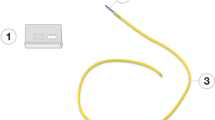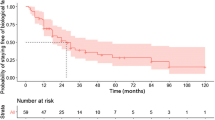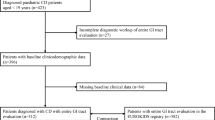Abstract
The transmural inflammation characteristic of Crohn's disease predisposes patients to the formation of fistulas. Up to 50% of patients with Crohn's disease are affected by fistulas, which is a major problem given the considerable morbidity associated with this complication. Appropriate treatment of fistulas requires knowledge of specific pharmacological and surgical therapies. Treatment options depend on the severity of symptoms, fistula location, the number and complexity of fistula tracts, and the presence of rectal complications. Internal fistulas, such as ileoileal or ileocecal fistulas, are mostly asymptomatic and do not require intervention. By contrast, perianal fistulas can be painful and abscesses may develop that require surgical drainage with or without seton placement, transient ileostomy, or in severe cases, proctectomy. This Review describes the epidemiology and pathology of fistulizing Crohn's disease. Particular focus is given to external and perianal fistulas, for which treatment options are well established. Available therapeutic options, including novel therapies, are discussed. Wherever possible, practical and evidence-based treatment regimens for Crohn's disease-associated fistulas are provided.
Key Points
-
Fistulas are a major problem for patients with Crohn's disease, and occur in up to 50% of patients
-
Treatments for fistulizing Crohn's disease have evolved greatly over the past decade, mostly as a result of the introduction of biologic therapy
-
The classification of fistulas in patients with Crohn's disease remains poorly defined and largely investigator-dependent, although MRI might provide objective information
-
A treatment algorithm for fistulizing Crohn's disease is presented; however, an optimal outcome is dependent on the use of a multidisciplinary approach
This is a preview of subscription content, access via your institution
Access options
Subscribe to this journal
Receive 12 print issues and online access
$209.00 per year
only $17.42 per issue
Buy this article
- Purchase on Springer Link
- Instant access to full article PDF
Prices may be subject to local taxes which are calculated during checkout





Similar content being viewed by others
References
Judge TA and Lichtenstein GR (2004) Treatment of fistulizing Crohn's disease. Gastroenterol. Clin North Am 33: 421–454
Hellers G et al. (1980) Occurrence and outcome after primary treatment of anal fistulae in Crohn's disease. Gut 21: 525–527
Schwartz DA et al. (2002) The natural history of fistulizing Crohn's disease in Olmsted County, Minnesota. Gastroenterology 122: 875–880
Solomon MJ (1996) Fistulae and abscesses in symptomatic perianal Crohn's disease. Int J Colorectal Dis 11: 222–226
Sandborn WJ et al. (2003) Tacrolimus for the treatment of fistulas in patients with Crohn's disease: a randomized, placebo-controlled trial. Gastroenterology 125: 380–388
American Gastroenterological Association Clinical Practice Committee (2003) American Gastroenterological Association medical position statement: perianal Crohn's disease. Gastroenterology 125: 1503–1507
Williamson PR et al. (1995) Twenty-year review of the surgical management of perianal Crohn's disease. Dis Colon Rectum 38: 389–392
Ky AJ et al. (2008) Collagen fistula plug for the treatment of anal fistulas. Dis Colon Rectum 51: 838–843
Schwartz DA et al. (2001) A comparison of endoscopic ultrasound, magnetic resonance imaging, and exam under anesthesia for evaluation of Crohn's perianal fistulas. Gastroenterology 121: 1064–1072
Kuijpers HC and Schulpen T (1985) Fistulography for fistula-in-ano. Is it useful? Dis Colon Rectum 28: 103–104
West RL et al. (2005) Perianal fistulas in Crohn's disease are predominantly colonized by skin flora: implications for antibiotic treatment? Dig Dis Sci 50: 1260–1263
Bataille F et al. (2004) Morphological characterisation of Crohn's disease fistulae. Gut 53: 1314–1321
Leeb SN et al. (2003) Reduced migration of fibroblasts in inflammatory bowel disease: role of inflammatory mediators and focal adhesion kinase. Gastroenterology 125: 1341–1354
Leeb SN et al. (2004) Autocrine fibronectin-induced migration of human colonic fibroblasts. Am J Gastroenterol 99: 335–340
Dignass AU (2001) Mechanisms and modulation of intestinal epithelial repair. Inflamm Bowel Dis 7: 68–77
Goke M et al. (1996) Regulation and function of extracellular matrix intestinal epithelial restitution in vitro. Am J Physiol 271: G729–G740
Podolsky DK (1997) Healing the epithelium: solving the problem from two sides. J Gastroenterol 32: 122–126
Tarnawski AS (2005) Cellular and molecular mechanisms of gastrointestinal ulcer healing. Dig Dis Sci 50 (Suppl 1): S24–S33
Kalluri R and Neilson EG (2003) Epithelial-mesenchymal transition and its implications for fibrosis. J Clin Invest 112: 1776–1784
Lee JM et al. (2006) The epithelial-mesenchymal transition: new insights in signaling, development, and disease. J Cell Biol 172: 973–981
Arias AM (2001) Epithelial mesenchymal interactions in cancer and development. Cell 105: 425–431
Thiery JP (2003) Epithelial-mesenchymal transitions in development and pathologies. Curr Opin Cell Biol 15: 740–746
Irvine EJ (1995) Usual therapy improves perianal Crohn's disease as measured by a new disease activity index. McMaster IBD Study Group. J Clin Gastroenterol 20: 27–32
Present DH et al. (1999) Infliximab for the treatment of fistulas in patients with Crohn's disease. N Engl J Med 340: 1398–1405
Sandborn WJ et al. (2002) A review of activity indices and efficacy endpoints for clinical trials of medical therapy in adults with Crohn's disease. Gastroenterology 122: 512–530
Best WR et al. (1976) Development of a Crohn's disease activity index. National Cooperative Crohn's Disease Study. Gastroenterology 70: 439–444
Present DH et al. (1980) Treatment of Crohn's disease with 6-mercaptopurine. A long-term, randomized, double-blind study. N Engl J Med 302: 981–987
Dejaco C et al. (2003) Antibiotics and azathioprine for the treatment of perianal fistulas in Crohn's disease. Aliment Pharmacol Ther 18: 1113–1120
Ardizzone S et al. (2004) Perianal fistulae following infliximab treatment: clinical and endosonographic outcome. Inflamm Bowel Dis 10: 91–96
Sands BE et al. (2004) Infliximab maintenance therapy for fistulizing Crohn's disease. N Engl J Med 350: 876–885
Nielsen OH and Munck LK (2007) Drug insight: aminosalicylates for the treatment of IBD. Nat Clin Pract Gastroenterol Hepatol 4: 160–170
Jones JH and Lennard-Jones JE (1966) Corticosteroids and corticotrophin in the treatment of Crohn's disease. Gut 7: 181–187
Sparberg M and Kirsner JB (1966) Long-term corticosteroid therapy for regional enteritis: an analysis of 58 courses in 54 patients. Am J Dig Dis 11: 865–880
Malchow H et al. (1984) European Cooperative Crohn's Disease Study (ECCDS): results of drug treatment. Gastroenterology 86: 249–266
Brandt LJ et al. (1982) Metronidazole therapy for perineal Crohn's disease: a follow-up study. Gastroenterology 83: 383–387
Jakobovits J and Schuster MM (1984) Metronidazole therapy for Crohn's disease and associated fistulae. Am J Gastroenterol 79: 533–540
Schneider MU et al. (1985) Metronidazole in the treatment of Crohn disease. Results of a controlled randomized prospective study [German]. Dtsch Med Wochenschr 110: 1724–1730
Bernstein LH et al. (1980) Healing of perineal Crohn's disease with metronidazole. Gastroenterology 79: 357–365
Prantera C et al. (1998) Use of antibiotics in the treatment of active Crohn's disease: experience with metronidazole and ciprofloxacin. Ital J Gastroenterol Hepatol 30: 602–606
Turunen U et al. (1993) Long-term outcome of ciprofloxacin treatment in severe perianal or fistulous Crohn's disease [abstract]. Gastroenterology 104: A793
West RL et al. (2004) Clinical and endosonographic effect of ciprofloxacin on the treatment of perianal fistulae in Crohn's disease with infliximab: a double-blind placebo-controlled study. Aliment Pharmacol Ther 20: 1329–1336
Nielsen OH et al. (2001) Review article: the treatment of inflammatory bowel disease with 6-mercaptopurine or azathioprine. Aliment Pharmacol Ther 15: 1699–1708
Korelitz BI and Present DH (1985) Favorable effect of 6-mercaptopurine on fistulae of Crohn's disease. Dig Dis Sci 30: 58–64
O'Brien JJ et al. (1991) Use of azathioprine or 6-mercaptopurine in the treatment of Crohn's disease. Gastroenterology 101: 39–46
Pearson DC et al. (1995) Azathioprine and 6-mercaptopurine in Crohn disease. A meta-analysis. Ann Intern Med 123: 132–142
Wheeler SC et al. (1998) Medical therapy, not surgery is the appropriate first line of treatment for Crohn's enterovesical fistula. Gastroenterology 114: A1113
Margolin ML and Korelitz BI (1989) Management of bladder fistulas in Crohn's disease. J Clin Gastroenterol 11: 399–402
Greenstein AJ et al. (1989) Gastric fistulas in Crohn's disease. Report of cases. Dis Colon Rectum 32: 888–892
Korelitz BI et al. (1993) Long-term experience with 6-mercaptopurine in the treatment of Crohn's disease. Am J Gastroenterol 88: 1198–1205
Cuffari C et al. (2001) Utilisation of erythrocyte 6-thioguanine metabolite levels to optimise azathioprine therapy in patients with inflammatory bowel disease. Gut 48: 642–646
Egan LJ et al. (1998) Clinical outcome following treatment of refractory inflammatory and fistulizing Crohn's disease with intravenous cyclosporine. Am J Gastroenterol 93: 442–448
Hanauer SB and Smith MB (1993) Rapid closure of Crohn's disease fistulas with continuous intravenous cyclosporin A. Am J Gastroenterol 88: 646–649
Present DH and Lichtiger S (1994) Efficacy of cyclosporine in treatment of fistula of Crohn's disease. Dig Dis Sci 39: 374–380
Gurudu SR et al. (1999) Cyclosporine therapy in inflammatory bowel disease: short-term and long-term results. J Clin Gastroenterol 29: 151–154
McDonald JW et al. Cyclosporine for induction of remission in Crohn's disease. Cochrane Database of Systematic Reviews 2005, Issue 2. Art. No.: CD000297
Plosker GL and Foster RH (2000) Tacrolimus: a further update of its pharmacology and therapeutic use in the management of organ transplantation. Drugs 59: 323–389
van Dullemen HM et al. (1995) Treatment of Crohn's disease with anti-tumor necrosis factor chimeric monoclonal antibody (cA2). Gastroenterology 109: 129–135
Peyrin-Biroulet L et al. (2008) Crohn's disease: beyond antagonists of tumour necrosis factor. Lancet 372: 67–81
Sands BE et al. (2004) Long-term treatment of rectovaginal fistulas in Crohn's disease: response to infliximab in the ACCENT II Study. Clin Gastroenterol Hepatol 2: 912–920
Lichtenstein GR et al. (2005) Infliximab maintenance treatment reduces hospitalizations, surgeries, and procedures in fistulizing Crohn's disease. Gastroenterology 128: 862–869
Theis VS and Rhodes JM (2008) Review article: minimizing tuberculosis during anti-tumour necrosis factor-alpha treatment of inflammatory bowel disease. Aliment Pharmacol Ther 27: 19–30
Hanauer SB et al. (2006) Human anti-tumor necrosis factor monoclonal antibody (adalimumab) in Crohn's disease: the CLASSIC-I trial. Gastroenterology 130: 323–333
Sandborn WJ et al. (2007) Adalimumab induction therapy for Crohn disease previously treated with infliximab: a randomized trial. Ann Intern Med 146: 829–838
Colombel JF et al. (2007) Adalimumab for maintenance of clinical response and remission in patients with Crohn's disease: the CHARM trial. Gastroenterology 132: 52–65
Baumgart DC and Sandborn WJ (2007) Inflammatory bowel disease: clinical aspects and established and evolving therapies. Lancet 369: 1641–1657
Sandborn WJ et al. (2007) Certolizumab pegol for the treatment of Crohn's disease. N Engl J Med 357: 228–238
Schreiber S et al. (2007) Maintenance therapy with certolizumab pegol for Crohn's disease. N Engl J Med 357: 239–250
Clark M et al. (2007) American gastroenterological association consensus development conference on the use of biologics in the treatment of inflammatory bowel disease, June 21–23, 2006. Gastroenterology 133: 312–339
Bongartz T et al. (2006) Anti-TNF antibody therapy in rheumatoid arthritis and the risk of serious infections and malignancies: systematic review and meta-analysis of rare harmful effects in randomized controlled trials. JAMA 295: 2275–2285
Askling J et al. (2005) Haematopoietic malignancies in rheumatoid arthritis: lymphoma risk and characteristics after exposure to tumour necrosis factor antagonists. Ann Rheum Dis 64: 1414–1420
Lichtenstein GR et al. (2007) Safety of infliximab and other Crohn's disease therapies—Treat Registry. Data with nearly 20,000 patient-years of follow-up [abstract]. Gastroenterology 132: A178
Sands BE et al. (2006) Maintenance infliximab does not result in increased abscess development in fistulizing Crohn's disease: results from the ACCENT II study. Aliment Pharmacol Ther 23: 1127–1136
Baert F et al. (2003) Influence of immunogenicity on the long-term efficacy of infliximab in Crohn's disease. N Engl J Med 348: 601–608
Fefferman DS and Farrell RJ (2005) Immunogenicity of biological agents in inflammatory bowel disease. Inflamm Bowel Dis 11: 497–503
van der Woude CJ and Hommes DW (2007) Biologics in Crohn's disease: searching indicators for outcome. Expert Opin Biol Ther 7: 1233–1243
Mackey AC et al. (2007) Hepatosplenic T cell lymphoma associated with infliximab use in young patients treated for inflammatory bowel disease. J Pediatr Gastroenterol Nutr 44: 265–267
Veres G et al. (2007) Infliximab therapy in children and adolescents with inflammatory bowel disease. Drugs 67: 1703–1723
Hanauer SB (2007) Risks and benefits of combining immunosuppressives and biological agents in inflammatory bowel disease: is the synergy worth the risk? Gut 56: 1181–1183
Korzenik JR et al. (2005) Sargramostim for active Crohn's disease. N Engl J Med 352: 2193–2201
Mahadevan U et al. (2003) Fistula response to methotrexate in Crohn's disease: a case series. Aliment Pharmacol Ther 18: 1003–1008
Soon SY et al. (2004) Experience with the use of low-dose methotrexate for inflammatory bowel disease. Eur J Gastroenterol Hepatol 16: 921–926
Feagan BG et al. (1995) Methotrexate for the treatment of Crohn's disease. The North American Crohn's Study Group Investigators. N Engl J Med 332: 292–297
Fukuda Y et al. (2008) Oral spherical adsorptive carbon for the treatment of intractable anal fistulas in Crohn's disease: a multicenter, randomized, double-blind, placebo-controlled trial. Am J Gastroenterol 103: 1721–1729
Fichera A and Michelassi F (2007) Surgical treatment of Crohn's disease. J Gastrointest Surg 11: 791–803
Williams JG et al. (2007) The treatment of anal fistula: ACPGBI position statement. Colorectal Dis 9 (Suppl 4): 18–50
Sangwan YP et al. (1996) Perianal Crohn's disease. Results of local surgical treatment. Dis Colon Rectum 39: 529–535
Levien DH et al. (1989) Surgical treatment of anorectal fistula in patients with Crohn's disease. Surg Gynecol Obstet 169: 133–136
Williams JG et al. (1991) Fistula-in-ano in Crohn's disease. Results of aggressive surgical treatment. Dis Colon Rectum 34: 378–384
Buchanan GN et al. (2004) Long-term outcome following loose-seton technique for external sphincter preservation in complex anal fistula. Br J Surg 91: 476–480
Makowiec F et al. (1995) Clinical course of perianal fistulas in Crohn's disease. Gut 37: 696–701
Hyman N (1999) Endoanal advancement flap repair for complex anorectal fistulas. Am J Surg 178: 337–340
Vasilevsky CA and Gordon PH (1984) The incidence of recurrent abscesses or fistula-in-ano following anorectal suppuration. Dis Colon Rectum 27: 126–130
Joo JS et al. (1998) Endorectal advancement flap in perianal Crohn's disease. Am Surg 64: 147–150
Jones IT et al. (1987) The use of transanal rectal advancement flaps in the management of fistulas involving the anorectum. Dis Colon Rectum 30: 919–923
Mizrahi N et al. (2002) Endorectal advancement flap: are there predictors of failure? Dis Colon Rectum 45: 1616–1621
Mueller MH et al. (2007) Risk of fecal diversion in complicated perianal Crohn's disease. J Gastrointest Surg 11: 529–537
Galandiuk S et al. (2005) Perianal Crohn disease: predictors of need for permanent diversion. Ann Surg 241: 796–801
Johnson EK et al. (2006) Efficacy of anal fistula plug vs. fibrin glue in closure of anorectal fistulas. Dis Colon Rectum 49: 371–376
Committee Consensus Statement (2008) The Surgisis® AFP™ anal fistula plug: report of a consensus conference. Colorectal Dis 10: 17–20
Schwandner O et al. (2008) Initial experience on efficacy in closure of cryptoglandular and Crohn's transsphincteric fistulas by the use of the anal fistula plug. Int J Colorectal Dis 23: 319–324
O'Connor L et al. (2006) Efficacy of anal fistula plug in closure of Crohn's anorectal fistulas. Dis Colon Rectum 49: 1569–1573
Loungnarath R et al. (2004) Fibrin glue treatment of complex anal fistulas has low success rate. Dis Colon Rectum 47: 432–436
Williamson PR et al. (1995) Twenty-year review of the surgical management of perianal Crohn's disease. Dis Colon Rectum 38: 389–392
Yamamoto T et al. (1999) Persistent perineal sinus after proctocolectomy for Crohn's disease. Dis Colon Rectum 42: 96–101
Collie MH et al. (2005) Myocutaneous flaps promote perineal healing in inflammatory bowel disease. Br J Surg 92: 740–741
Rius J et al. (2000) Gracilis transposition in complicated perianal fistula and unhealed perineal wounds in Crohn's disease. Eur J Surg 166: 218–222
Singh B et al. (2004) Perianal Crohn's disease. Br J Surg 91: 801–814
Bauer JJ et al. (1991) Transvaginal approach for repair of rectovaginal fistulae complicating Crohn's disease. Ann Surg 213: 151–158
Songne K et al. (2007) Treatment of anovaginal or rectovaginal fistulas with modified Martius graft. Colorectal Dis 9: 653–656
Sagar PM et al. (1996) Long-term results of ileal pouch–anal anastomosis in patients with Crohn's disease. Dis Colon Rectum 39: 893–898
Zmora O et al. (2001) Reoperative abdominal and perineal surgery in ileoanal pouch patients. Dis Colon Rectum 44: 1310–1314
Regan JP and Salky BA (2004) Laparoscopic treatment of enteric fistulas. Surg Endosc 18: 252–254
D'Haens G et al. (2008) Early combined immunosuppression or conventional management in patients with newly diagnosed Crohn's disease: an open randomised trial. Lancet 371: 660–667
da Luz MA et al. (2007) Laparoscopic surgery for patients with Crohn's colitis: a case-matched study. J Gastrointest Surg 11: 1529–1533
Fichera A et al. (2007) Laparoscopy or conventional open surgery for patients with ileocolonic Crohn's disease? A prospective study. Surgery 142: 566–571
Acknowledgements
The authors were supported by grants from Fonden til Lægevidenskabens Fremme (the AP Møller Foundation), the Augustinus Foundation, Aase and Ejnar Danielsens Foundation, and the Danish Research Agency, Ministry of Science, Technology and Innovation, grant #22-04-0622. Charles P Vega, University of California, Irvine, CA, is the author of and is solely responsible for the content of the learning objectives, questions and answers of the Medscape-accredited continuing medical education activity associated with this article.
Author information
Authors and Affiliations
Corresponding author
Ethics declarations
Competing interests
G Rogler has received grant/research support from Abbott and UCB Pharma. OØ Thomsen has received grant/research support from UCB Pharma. OH Nielsen and D Hahnloser declared no competing interests.
Rights and permissions
About this article
Cite this article
Nielsen, O., Rogler, G., Hahnloser, D. et al. Diagnosis and management of fistulizing Crohn's disease. Nat Rev Gastroenterol Hepatol 6, 92–106 (2009). https://doi.org/10.1038/ncpgasthep1340
Received:
Accepted:
Published:
Issue Date:
DOI: https://doi.org/10.1038/ncpgasthep1340
This article is cited by
-
Management of perianal fistula in inflammatory bowel disease: identification of prognostic factors associated with surgery
Langenbeck's Archives of Surgery (2021)
-
Prevalence of Anal Fistulas in Europe: Systematic Literature Reviews and Population-Based Database Analysis
Advances in Therapy (2019)
-
An open prospective study evaluating efficacy and safety of a new medical device for rectal application of activated carbon in the treatment of chronic, uncomplicated perianal fistulas
International Journal of Colorectal Disease (2017)



